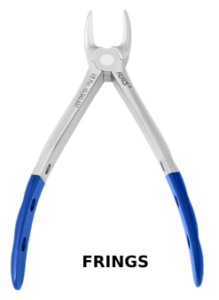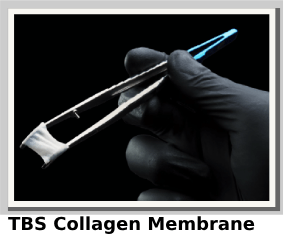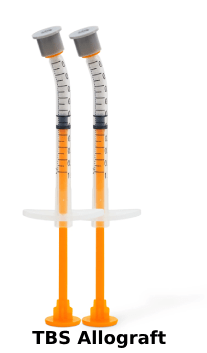
TBS DENTAL
Providing Optimal Care
to Your Patients Following
Tooth Extraction
Dr. Jay Reznick shares how several tools and materials from TBS Dental contribute to successful alveolar ridge preservation and happy patients
One of the most commonly performed procedures in dentistry is the removal of a non-restorable or
fractured tooth. Traditionally, missing teeth would be replaced by either a fixed or a removable prosthesis,
but in the 1980s, successful, predictable, and simplified dental implants were introduced to dentistry. By
the 2000s, clinicians started to realize that replacement of a missing tooth with a dental implant helped maintain the dimensions of the alveolar ridge and avoided the need to prepare the adjacent teeth to anchor a fixed prosthesis. Patients also found that maintaining good oral hygiene around an implant-supported crown was much easier than with a fixed bridge.
Minimizing Resorption After Extraction
Sometimes, tooth roots can be replaced at the time of removal with an implant fixture and provisional crown, especially in the anterior esthetic zone. This helps to maintain both alveolar ridge volume and soft tissue contours due to the implant fixture transmitting functional stress to the bone, thus following the concepts of Wollf’s Law. But when this is not feasible, the alveolar socket must heal sufficiently before a dental implant can be placed. During this 3- to 6-month period of healing, there is no functional stress on the bone, which means that ridge resorption occurs, especially in the first few months. This results in a reduction of the alveolar height and width. Often, it can be so severe that there is inadequate bone volume to support a dental implant where the tooth was extracted.
To minimize the resorption of the edentulous alveolar ridge, many clinicians studied ways to minimize this bone loss, which would allow a dental implant to be placed once the ridge had healed sufficiently. Thus, the concept of alveolar ridge preservation grafting was born. Immediately following tooth removal, the site is prepared to minimize the natural ridge resorption that is known to occur in the first few months after the tooth is removed. The concept of ridge preservation is fairly straightforward.
Extract with TBS, Fill with TBS
First, the tooth is removed using instruments to minimize trauma to the alveolus and soft tissues. I like TBS Dental’s Elvatome 2.0, which severs the periodontal

ligament, expands the alveolar bone, and gently luxates the tooth roots. Then, using the
company’s FRINGS forceps, which are specifically designed for each area
of the mouth, the tooth is easily and gently removed from the socket. Next, the socket is carefully debrided to remove all infected tissues, such as granulation tissue and apical lesions, followed by copious irrigation. As
I like to say, “The solution to pollution is dilution!” Next, the socket is filled completely with a bone graft material to form a matrix through which healthy dense bone will form. Different materials have been used over the years with various success, including freezedried coral, hydroxyapatite crystals, glass-like spheres, collagen
scaffoldings, xenograft particles from cow, pig, and horse, as well as human allograft particulate bone. The gold standard is to use allogeneic bone from the patient, but
that requires a second surgical site to harvest the bone, as well as preparation of the graft before placement, which means it is rarely used. I like using TBS Allograft,
which comes preloaded in a 0.5-cc specially designed syringe that allows for saline, the patient’s
blood, or liquid PRF to be drawn in to hydrate the bone. It can then be easily delivered into the
extraction socket until full by advancing the plunger. For multiple extraction sites, TBS Allograft
powder is available in a 2.5-cc jar. Finally, the grafted socket is covered with a barrier membrane to

keep the graft in place and to prevent soft tissue in-growth
into the maturing graft. TBS Collagen Membrane has
crosslinked collagen fibers, which slows resorption to
keep the allograft protected for around 8 weeks. After
allowing for about 3 to 6 months for integration of the alveolar ridge preservation graft, dental implant planning may take place.
Ridge Preservation as an Insurance Policy


Tooth replacement options should be discussed with all patients prior to extraction. The benefits and drawbacks of a removeable appliance, fixed bridge, implant-supported fixed prostheses, or no treatment at all should be part of the conversation. Most of the time, patients will opt for the dental implant once the options are presented. Sometimes, patients are unsure about what to do and may want to “see how much they miss the tooth.” In these cases, I suggest to my patients that we do the ridge preservation graft to keep their options open should they decide that a dental implant is to be placed. I describe it as an “insurance policy.” I hate for a patient to opt out of the graft, and then 4 months later announce that they want an implant, but there is now inadequate bone volume to place one without first performing bony augmentation.
Being able to provide alveolar ridge preservation grafting allows the clinician to deliver state-of-the-art dental care to their patients. It also provides financial benefits to the dental practice. It is a simple, predictable procedure that will hopefully lead to treatment with an implant-supported prosthesis and a happy patient.
This article was produced in partnership with TBS Dental.




